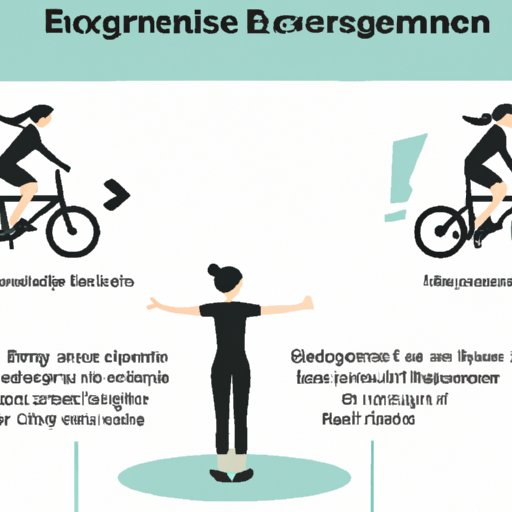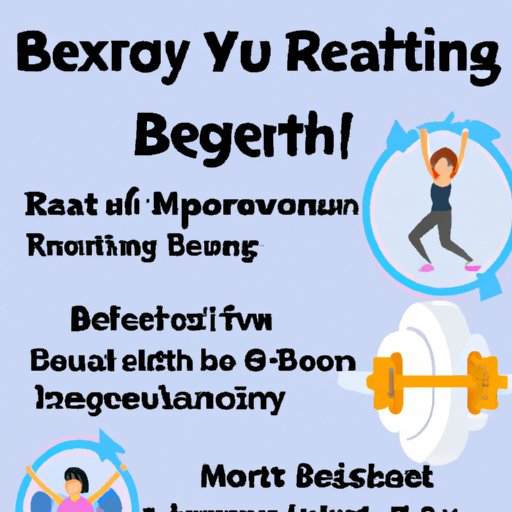
Introduction: Benefits of Regular Exercise
Exercise is essential for staying healthy and fit. Regular physical activity can help improve your strength, cardiovascular health, and mental health. It can also help prevent chronic diseases like obesity, heart disease, and diabetes. But just how much exercise do you need to get these benefits? That’s what we’ll explore in this article.
The Centers for Disease Control and Prevention (CDC) recommends that adults get at least 150 minutes of moderate-intensity aerobic activity or 75 minutes of vigorous-intensity aerobic activity each week. However, the amount of exercise you need may vary depending on your age and activity level. In this article, we’ll look at how much exercise you need based on your age and activity level. We’ll also discuss the different types of exercise and the science behind how much exercise you need to stay healthy and fit.

A Guide to How Much Exercise You Need Based on Your Age and Activity Level
When it comes to how much exercise you need, it’s important to consider your age and activity level. Here’s a guide to the amount of exercise recommended for different age groups:
Young Adults (20-29)
Young adults are typically very active and able to handle more intense exercise. The CDC recommends that young adults get 150 minutes of moderate-intensity aerobic activity or 75 minutes of vigorous-intensity aerobic activity each week. Additionally, they should do muscle-strengthening activities at least twice a week.
Middle-Aged Adults (30-49)
For middle-aged adults, the CDC recommends 150 minutes of moderate-intensity aerobic activity or 75 minutes of vigorous-intensity aerobic activity each week. They should also do muscle-strengthening activities at least twice a week. Additionally, middle-aged adults should focus on flexibility and balance exercises to reduce their risk of falls.
Older Adults (50+)
Older adults should aim for at least 150 minutes of moderate-intensity aerobic activity or 75 minutes of vigorous-intensity aerobic activity each week. They should also do muscle-strengthening activities at least twice a week and focus on flexibility and balance exercises to reduce their risk of falls. Additionally, older adults should engage in activities that promote social interaction and cognitive stimulation.

The Benefits of Regular Exercise and How Much You Should Do
Regular exercise can provide a variety of health benefits, including improved strength and endurance, improved cardiovascular health, and improved mental health. Here’s a closer look at the benefits of regular exercise and how much you should do to reap those benefits.
Improved Strength and Endurance
Strength training is an important part of any exercise routine. According to the American College of Sports Medicine, adults should do strength training exercises at least two days a week. Each session should include 8-10 exercises that target all major muscle groups. The exercises should be performed with enough intensity and volume to fatigue the muscles.
Improved Cardiovascular Health
Getting regular aerobic exercise is essential for improving your cardiovascular health. The American Heart Association recommends that adults get at least 150 minutes of moderate-intensity aerobic activity or 75 minutes of vigorous-intensity aerobic activity each week. Additionally, you should do strength training exercises at least twice a week.
Improved Mental Health
Regular exercise can also help improve your mental health. According to a study published in the British Journal of Sports Medicine, people who exercised regularly reported lower levels of anxiety, depression, and stress than those who did not exercise. The researchers concluded that 30 minutes of moderate-intensity exercise five days a week was enough to improve mental health.
Understanding the Different Types of Exercise and How Much You Need for Optimal Health
There are four main types of exercise that you should incorporate into your routine: aerobic exercise, resistance training, flexibility and balance exercises, and core exercises. Here’s a closer look at each type of exercise and how much you should do for optimal health.
Aerobic Exercise
Aerobic exercise is any activity that increases your heart rate and breathing. Examples of aerobic exercise include walking, jogging, swimming, cycling, and dancing. The American Heart Association recommends that adults get at least 150 minutes of moderate-intensity aerobic activity or 75 minutes of vigorous-intensity aerobic activity each week.
Resistance Training
Resistance training is any exercise that uses weights or resistance bands to build muscle strength and endurance. The American College of Sports Medicine recommends that adults do strength training exercises at least two days a week. Each session should include 8-10 exercises that target all major muscle groups. The exercises should be performed with enough intensity and volume to fatigue the muscles.
Flexibility and Balance Exercises
Flexibility and balance exercises are important for maintaining mobility and reducing the risk of falls. The American College of Sports Medicine recommends that adults do flexibility and balance exercises at least two days a week. Examples of flexibility and balance exercises include yoga, tai chi, and Pilates. These exercises should be done slowly and with control.
Core Exercises
Core exercises are any exercises that target the abdominals, back, and hips. They help strengthen the muscles in the core, which helps improve posture and reduce back pain. The American College of Sports Medicine recommends that adults do core exercises at least two days a week. Examples of core exercises include planks, crunches, and leg lifts.

The Science Behind How Much Exercise You Need to Stay Healthy and Fit
In order to get the most out of your exercise routine, it’s important to understand the science behind how much exercise you need. Here’s an overview of the science behind how much exercise you need to stay healthy and fit.
Heart Rate Zones
Your heart rate is one of the best indicators of how hard you’re working during exercise. There are five heart rate zones that you should be aware of: resting, light, moderate, hard, and maximum. Knowing which zone you’re in will help you determine how hard you’re working and how much exercise you need to reach your goals.
The Benefits of Intensity and Duration
The intensity and duration of your exercise can have a big impact on your results. The higher the intensity, the more calories you’ll burn. The longer the duration, the more time your body has to adapt to the exercise and see results. To get the most out of your exercise routine, you should aim for both high intensity and long duration.
Nutrition and Hydration
Nutrition and hydration are also important for getting the most out of your exercise routine. Eating a balanced diet and drinking plenty of water before, during, and after exercise will help keep your energy levels up and reduce your risk of dehydration. Additionally, eating a post-workout snack within 30 minutes of finishing your workout can help replenish energy stores and repair muscle tissue.
How to Build an Exercise Routine That Meets Your Health Goals
Creating an effective exercise routine can seem daunting, but it doesn’t have to be. Here are some tips for building an exercise routine that meets your health goals:
Setting Goals
Before you start exercising, it’s important to set realistic goals. Think about what you want to accomplish with your exercise routine and make sure your goals are achievable. For example, if your goal is to lose weight, set a timeline and track your progress.
Creating A Schedule
Once you’ve set your goals, it’s time to create a schedule. Make sure you’re setting aside enough time each week to fit in all the exercise you need. Also, try to find activities that you enjoy doing so that you’ll be more likely to stick with them.
Tracking Progress
Finally, it’s important to track your progress. Keeping track of your workouts and recording your results can help you stay motivated and reach your goals. You can use a fitness tracker or journal to track your progress.
An Overview of the Recommended Amount of Exercise for Different Groups of People
Here’s an overview of the recommended amount of exercise for different groups of people:
Children and Adolescents
The American Academy of Pediatrics recommends that children and adolescents get at least 60 minutes of moderate-to-vigorous physical activity every day. This should include aerobic exercises, muscle-strengthening activities, and flexibility and balance exercises.
Adults
The Centers for Disease Control and Prevention (CDC) recommends that adults get at least 150 minutes of moderate-intensity aerobic activity or 75 minutes of vigorous-intensity aerobic activity each week. Additionally, adults should do muscle-strengthening activities at least twice a week and flexibility and balance exercises at least twice a week.
Elderly
Older adults should aim for at least 150 minutes of moderate-intensity aerobic activity or 75 minutes of vigorous-intensity aerobic activity each week. They should also do muscle-strengthening activities at least twice a week and focus on flexibility and balance exercises to reduce their risk of falls. Additionally, older adults should engage in activities that promote social interaction and cognitive stimulation.
Conclusion
Exercise is essential for staying healthy and fit. Regular physical activity can help improve your strength, cardiovascular health, and mental health. The amount of exercise you need may vary depending on your age and activity level, but the general recommendation is to get at least 150 minutes of moderate-intensity aerobic activity or 75 minutes of vigorous-intensity aerobic activity each week. Additionally, adults should do muscle-strengthening activities at least twice a week and flexibility and balance exercises at least twice a week.
By understanding the different types of exercise and the science behind how much exercise you need, you can create an effective exercise routine that meets your health goals. Remember to set realistic goals, create a schedule, and track your progress to ensure you’re getting the most out of your exercise routine.
No matter your age or activity level, regular exercise is essential for staying healthy and fit. With the right approach, you can create an exercise routine that works for you and helps you reach your health goals.
(Note: Is this article not meeting your expectations? Do you have knowledge or insights to share? Unlock new opportunities and expand your reach by joining our authors team. Click Registration to join us and share your expertise with our readers.)
